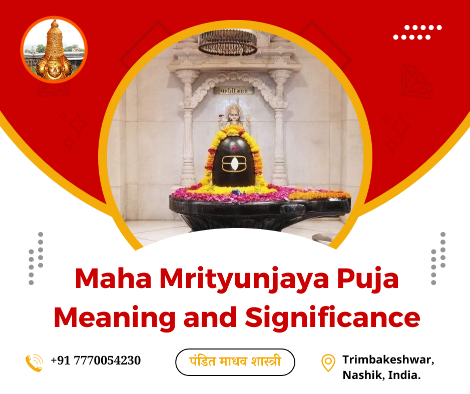
- January 1, 2025
- Pandit Madhav Shastri
- 0
Maha Mrityunjaya Puja Meaning and Significance in Hinduism
In the vast spiritual landscape of Hinduism, some mantras and rituals transcend time to offer solace, healing, and divine protection. Among them, Maha Mrityunjaya Puja holds a revered place. This sacred ritual centers around Lord Shiva and the powerful Maha Mrityunjaya Mantra, invoking protection from untimely death, relief from diseases, and spiritual awakening.
But what exactly is Maha Mrityunjaya Puja? Why is it so important? What happens during the puja? In this comprehensive post, we will explore the meaning, origin, significance, and practical insights into Maha Mrityunjaya Puja to help devotees and spiritual seekers deepen their understanding of this profound Hindu ritual.
What is Maha Mrityunjaya Puja?
Maha Mrityunjaya Puja is a Vedic ritual dedicated to Lord Shiva, performed to invoke the Maha Mrityunjaya Mantra—a potent prayer known for its life-protecting powers. The puja is performed to seek divine intervention for overcoming illness, fear of untimely death, mental distress, accidents, and negative planetary effects.
The mantra is chanted with great devotion:
“ॐ त्र्यम्बकं यजामहे सुगन्धिं पुष्टिवर्धनम्।
उर्वारुकमिव बन्धनान्मृत्योर्मुक्षीय माऽमृतात्॥”
Meaning:
“We meditate on the three-eyed one (Lord Shiva), who permeates and nourishes all like a fragrance. May He liberate us from death for the sake of immortality, just as a ripe cucumber separates itself from the vine.”
Origins of the Maha Mrityunjaya Mantra
The Maha Mrityunjaya Mantra finds its origin in the Rigveda (Mandala 7, Hymn 59). According to mythology, the sage Markandeya was saved from death by chanting this mantra and invoking Lord Shiva’s protection. Hence, it is often referred to as the “Markandeya Mantra.”
The mantra is believed to have been revealed to Rishi Vashishta, and later used by Rishi Markandeya, whose unwavering devotion and chanting saved him from Yama, the god of death.
Symbolic and Spiritual Meaning of the Puja
Each element of Maha Mrityunjaya Puja symbolizes deeper spiritual truths:
Lord Shiva as the Three-Eyed One (Tryambakam): Symbolizes wisdom (third eye), destruction of ego, and transcendence over duality.
Scent (Sugandhim): Represents the subtle essence of consciousness that nourishes spiritual growth.
Growth (Pushtivardhanam): Denotes both material and spiritual prosperity.
Liberation from Bondage (Bandhanan): Implies freedom from suffering, karma, and the cycle of birth and death.
Immortality (Amritat): Refers not to physical eternity, but liberation of the soul—Moksha.
Thus, the puja is not just about overcoming physical death but awakening to the eternal, divine Self within.
Why is Maha Mrityunjaya Puja Performed?
Many people wonder: Is Maha Mrityunjaya Puja only for people facing serious health issues? The answer is no. While the ritual is widely known for healing and protection from death, it serves multiple purposes, including:
Recovery from chronic or life-threatening illness
Protection from accidents and sudden death
Removal of doshas (planetary afflictions) in a birth chart
Mental peace and relief from anxiety or depression
Spiritual progress and removal of inner fears
Safeguarding family and loved ones
Mitigating the ill effects of Kaal Sarp Dosh or Pitra Dosh
Is it only for individuals?
No, the puja can be done for oneself, one’s family, or even for someone else’s well-being, with full faith and sankalp (intent).
How is Maha Mrityunjaya Puja Performed?
The puja is conducted with strict adherence to Vedic procedures by trained pandits or priests. Below is a typical outline of how the ritual unfolds:
1. Sankalp (Intention Setting)
The devotee offers a clear intention for whom and why the puja is being performed.
2. Gauri Ganesh Puja
Lord Ganesha and Goddess Gauri are invoked first to remove obstacles.
3. Kalash Sthapana
Sacred water is invoked into a copper pot (kalash), representing divinity.
4. Navagraha Puja
The nine planetary gods are worshipped to nullify any negative influences.
5. Invocation of Lord Shiva
Through Vedic hymns and the Maha Mrityunjaya Mantra, Lord Shiva is invited to reside in the lingam or image.
6. Abhishekam (Ritual Bathing of Shiva Lingam)
With substances like:
Milk – symbolizes purity
Honey – sweetness of life
Ghee – divine fire and healing
Sugar – joy
Water – flow of consciousness
Bilva leaves – Lord Shiva’s favorite offering
7. 108 or 1008 Mantra Jaap
The Maha Mrityunjaya Mantra is chanted 108 or 1008 times using a rudraksha mala, accompanied by offerings and incense.
8. Aarti and Prasad
The ritual ends with the waving of the aarti lamp and distribution of sanctified food (prasad).
Astrological and Planetary Significance
Maha Mrityunjaya Puja is particularly recommended during challenging planetary periods such as:
Mahadasha or Antardasha of Saturn (Shani), Mars (Mangal), Rahu, Ketu
Sade Sati or Shani Dhaiya
Rahu-Ketu afflictions, especially during Kaal Sarp Dosh
Pitra Dosh when ancestors’ blessings are blocked
Astrologers often advise this puja during:
Illness with no clear medical cause
Accidents or recurring misfortunes
Fear of early or unnatural death
Unexplained negative energy or black magic
Pregnancy complications or childbirth issues
When Should Maha Mrityunjaya Puja Be Done?
While the puja can be done on any day, some days hold special significance:
Maha Shivaratri
Mondays, particularly in the month of Sawan (Shravan)
Pradosh Vrat
Chaturdashi Tithi (14th lunar day)
Amavasya or Purnima
Nakshatras such as Ardra, Mrigashira, or Rohini
Many people choose to perform it on birthdays, anniversaries of recovery, or during major life transitions.
Where is the Best Place to Perform Maha Mrityunjaya Puja?
This puja can be performed at:
Home (by experienced pandits or via online services)
Shiva temples, especially Jyotirlingas like:
Trimbakeshwar (Nashik)
Kashi Vishwanath (Varanasi)
Somnath (Gujarat)
Kedarnath (Uttarakhand)
Online Puja Services – offer convenience with livestream and remote sankalp
Benefits of Maha Mrityunjaya Puja
Let’s explore the holistic benefits of performing this sacred ritual:
Physical and Mental Healing
The mantra’s vibrations promote calmness, reduce stress, and are believed to aid in recovery from disease.
Protection from Untimely Death
True to its name (“Mrityunjaya” means conqueror of death), the puja invokes Shiva’s grace to prevent unnatural death.
Karma and Dosha Cleansing
The ritual helps neutralize karmic baggage, remove negative energies, and pacify Navagraha doshas.
Peace, Prosperity, and Longevity
It promotes a sense of emotional security, clarity, and spiritual grounding.
Spiritual Growth
For spiritual aspirants, the puja opens channels for higher consciousness, devotion (bhakti), and moksha.
Frequently Asked Questions (FAQs)
1. Can Maha Mrityunjaya Puja be done at home?
Yes. If a qualified priest is available, it can be done at home. Alternatively, you can opt for live online puja through trusted platforms.
2. How much time does the puja take?
Depending on the number of mantra repetitions, it can take between 2 to 6 hours.
3. Can anyone chant the Maha Mrityunjaya Mantra?
Yes. Devotees of all ages and genders can chant the mantra with purity of intent and devotion.
4. Is there a specific number of times the mantra should be chanted?
Ideally, 108, 1008, or 1.25 lakh times are considered auspicious. Regular daily chanting is highly beneficial.
5. How much does Maha Mrityunjaya Puja cost?
Costs vary depending on the location and scale:
Simple home puja: ₹3,000 – ₹7,000
Temple or online puja: ₹5,000 – ₹15,000
1.25 lakh jaap with havan: ₹25,000 – ₹75,000
6. What should one do after the puja?
Maintain a clean, calm, and prayerful state. Continue mantra chanting and donate food or essentials in Lord Shiva’s name for enhanced merit.
Final Thoughts: The Eternal Power of Shiva’s Grace
Maha Mrityunjaya Puja is not just a remedy—it is a spiritual gift. Whether you are struggling with health, fear, or looking for deeper connection, this puja offers a powerful bridge to Lord Shiva’s healing presence.
In the rhythm of the mantra lies a timeless truth—that death is not an end, but a doorway. With faith, discipline, and surrender, Maha Mrityunjaya Puja becomes a path not just to protection but to liberation.
So, whether you’re battling visible dangers or unseen fears, let this ancient prayer be your guide. Let the voice of Lord Shiva echo through your soul and bring peace, strength, and transformation.
